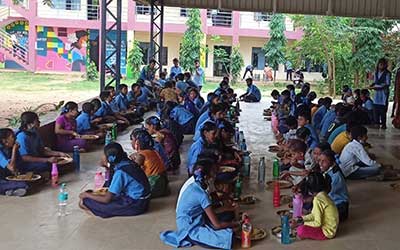Relevance: GS-2: Issues relating to development and management of Social Sector/Services relating to Health, Human Resources
Key Phrases: Food Inflation, National Family Health Surveys (NFHSs), Child Malnutrition, Micronutrient Deficiencies, Food Budget of Low-Income Families, Global Wheat Shortage, Agricultural Logistics, PM Garib Kalyan Anna Yojana
Why in News?
- Currently, inflation is running at 7.8 percent and food inflation is at 8.4 percent.
- In case food prices rise by 20 percent, families may be able to afford 20 percent less food if the scope for spending from savings or to increase the income, is missing.
- The burden of such a reduction in food purchases is more likely to fall on women and children.
Key Highlights:
- In India, child malnutrition has been improving gradually.
- Between the last two National Family Health Surveys (NFHSs) conducted in 2015-16 and 2019-21, children who are underweight reduced by 3.7 percentage points, those who are stunted reduced by 2.9 percentage points, and those who are wasted reduced by 1.7 percentage points, which is good progress.
- However, disruptions due to two years of the Covid-19 pandemic and the recent macroeconomic situation would lead to an increase in malnutrition in the coming years.
- Expenses like house rent, fuel, electricity, educational expenses, etc., are externally controlled. Eventually, families will buy less food, and most often children will bear the brunt.
- Micronutrient deficiencies are found to be high in normal times and can be expected to rise in times of inflation and low incomes.
- In such conditions, the first things families will cut out are fruits and vegetables as they are relatively costlier than other food items (cereals), but they are the main sources of micronutrients.
What is Malnutrition?
Malnutrition refers to deficiencies, excesses or imbalances in a person’s intake of energy and/or nutrients. It covers two different categories of conditions that are given below:
- Under-nutrition: This category covers stunting (low height for age), wasting (low weight for height), underweight (low weight for age) and micronutrient deficiencies (lack of important minerals)
- Others: This category consists of overweight, obesity, diet-related non-communicable diseases (such as heart disease, stroke, diabetes, and cancer)
Negative Impacts of Malnutrition
- Affects the productivity of the population
- Affects the country’s mortality rates
- Affects the survival rate of children
- Affects the learning capability of children, making them unproductive in their later life.
Factors behind increasing Food Inflation:
- Pandemic Impact:
- The pandemic had hit the economy hard, especially the unorganized sectors.
- Unemployment has also peaked recently and workforce participation has declined, indicating that people out of work are not looking for employment.
- All these have led to reduced income in poor and lower non-fixed-income households.
- When incomes reduce, it has a cascading impact on the incomes of small businesses such as fruit and vegetable vendors, kirana shops, tailors, etc.
- Russia-Ukraine War:
- The Russia-Ukraine war and the disruptions of supplies of grain, oil, gas, and many commodities have pushed global inflation to historic highs.
- Heatwaves:
- Record-breaking high temperatures in March and April in India led to a dip in wheat production.
- This along with the global wheat shortage has led to a price increase in wheat and other cereals.
- Agricultural Logistics:
- One of the factors for food inflation is poor logistics, wastage, and other inefficiencies.
Impact of High Food Inflation:
- Low incomes, combined with high inflation, will definitely disturb the food budget of low-income families.
- Around 68 percent of Indians live on under-$2 per day, and hence are on the margins of poverty.
- This will lead to increasing rates of malnutrition in the country. It may reverse the gains of the last 30 years of improvement in the nutritional status.
Way Forward:
- Global Collaboration for improving Nutritional Status:
- The Centre and State governments as well as UN agencies like UNICEF, WHO, etc., have to immediately start working on ways to reduce the impact of this perfect storm on the nutritional status of women and children.
- Boosting the budget:
- The budget for the ICDS (Integrated Child Development Services) and MDM (mid-day meal) schemes have to be increased to adjust for the rise in commodity and fuel prices.
- The PM Garib Kalyan Anna Yojana (PM-GKAY) may have to continue to give subsidised rations to the poor for a longer time and may need higher budgets.
- Distribution of essential micronutrients:
- Along with this, the government must think of the subsidised distribution of essential micronutrients (vitamins and minerals) to the poor.
- One tablet a day will not cost more than 25 paise per person.
- Agricultural Logistics:
- The government must make the agriculture logistics more efficient as well as try to reduce the margins of traders to reduce prices.
Conclusion:
- Food and fuel prices may surge even more in the coming months.
- If the monsoon, thankfully predicted to be normal, fails this year then it will worsen the nutritional situation of women and children.
- Fortunately, the government has cut fuel prices, a much-needed measure to cool the inflation, but that alone is not enough.
- In sum, if the nutritional safety nets such as ICDS, MDM and PMGKAY are not strengthened substantially, we are going to witness malnutrition in the days to come, given this perfect local and global storm. So, it’s better the earlier.
Source: The Hindu BL
Mains Question:
Q. The increasing rates of malnutrition on account of the increasing food inflation in the country may reverse the gains of the last 30 years of improvement in the nutritional status. In this respect, discuss the causes of rising food inflation and the measures needed for improving the nutritional status of the vulnerable sections. (250 words).








